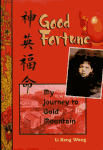|
The AACP Newsletter Asian American Curriculum Project, Inc. - Books for All Ages |
|||
|
|
|||||
|
Conversations with the Author and Illustrator of "A Place Where Sunflowers Grow" The following two interviews were conducted by Children's Book Press Thank you Children's Book Press for allowing us to use these interviews for our newsletter. |
|
|
|
|
Q: What inspired you to write A Place Where Sunflowers Grow?
Q: What do you find compelling about the internment camp art schools? |
Q: Why did you incorporate sunflowers into the story?
Q: What would you like young readers to learn from A Place Where Sunflowers Grow? |
|
|
|
Q: What do you like about illustrating children's books?
Q: What made illustrating A Place Where Sunflowers Grow different from your other projects?
Q: What resources did you use to create the art for A Place Where Sunflowers Grow? |
the National Japanese American Historical Society, where they let me examine their collection of photographs on interment camp life. Other books I found extremely helpful were collections of artists' work from when they were interned, such as Peaceful Painter: Hisako Hibi, Topaz Moon: Chiura Obata's Art of the Internment, and The Children of Topaz. But the most inspiring resources came from the author's mother, Ibuki Hibi Lee, who kindly lent me photo albums of her own mother's (Hisako Hibi's) artwork, as well as a collection of actual sketches.
Q: The characters are so expressive and Mari's emotions are very tangible. How were you able to capture so much?
Q: What did you take away from this project? |
The following books are discounted for subscribers to our newsletter. The discounts on these books end July 14, 2006. | |

|
A Place Where Sunflowers GrowBy Amy Lee-TaiIllustrated by Felicia Hoshino 2006, 31 pages, Hardback. Follow the inspirational story of Mari, a girl incarcerated with her family in a World War II Japanese American Internment camp at Topaz, Utah. Like her sunflowers, Mari must learn to cope and flourish in this harsh and oppressive environment. Note, author Amy Lee-Tai is the daughter of author Ibuki Hibi Lee who we interviewed in July 2005. Click here to read the interview.
View Additional Information
|

|
Snakeskin ShamisenBy Naomi Hirahara2006, 255 pages, Paperback. The Snakeskin Shamisen is the perfect summer read. It's a real page-turner that grabs your interest from page one. The Snakeskin Shamisen is a murder mystery novel that's filled with lots of Japanese American, Southern Californian, Hawaiian, and other culture and language tidbits that wonderfully illustrates the life Mas Arai and its other characters.
View Additional Information
|

|
Good Fortune
By Li Keng Wong |

|
WeedflowerBy Cynthia Kadohata2006, 260 pages, Hardback. Twelve-year-old Sumiko greatly anticipates a school friend's birthday party, but upon arriving is asked to leave because she is Japanese. This action sets the tone for the narrative as the family is separated and forced to relocate into two different Japanese American Internment camps during WWII. Placed in a camp located on an Indian Reservation where they don't want to be and the Indians don't want them, Sumiko finds life harsh with sand blown into their homes through the cracks in the walls, few creature comforts, and nothing to do. She meets an Indian boy who makes deliveries to the camp. Their friendship is tentative at first, but gradually builds as they help each other through trying times.
View Additional Information
|

|
Naming MayaBy Uma Krishnaswami2004, 178 pages, Hardback. Naming Maya is a summer journey of both the physical and personal kind. The main character Maya and her mother, spend the summer in Chennai (Madras, India), far away from their home in America, trying to sell Maya's grandfather's house. Maya must deal with issues concerning her parent's divorce, her strained relationship with her mother, growing up, and a beloved family friend's dementia. In addition, Maya's immersion in Indian culture and society is a learning experience for her and readers of this book.
View Additional Information
|
Copyright © 2006 by Asian American Curriculum Project, Inc. (a non-profit organization since 1970)
Interviews Copyright © 2006 by Children's Book Press
Visit our website at AsianAmericanBooks.com
To unsubscribe simply reply to this email and type "REMOVE" in the subject line.